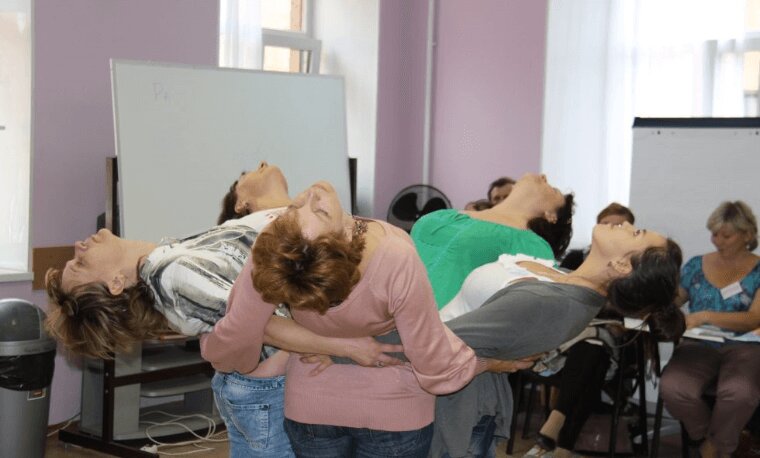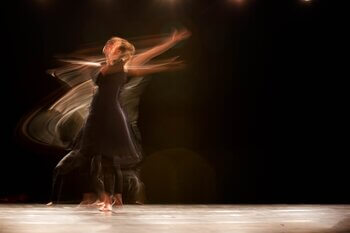
Why we don’t like to interact with our body
Past traumatic experiences contribute to a distorted connection between body and mind. It happens because unprocessed trauma is stored in the body. In order to survive painful past experiences, a person uses the dissociation between body and mind as a coping mechanism. This strategy works for survival but also contributes to a negative perception of the body. A person with, for example, a history of abuse and/or bullying, develops poor body awareness and often have “the sensation of being rigid mass, moving as a block” (Muller-Pinget, Carrad, Ybarra, & Golay, 2012). Negative attitude towards embodiment and appearance decreases self-esteem and creates resistance to physical movements. Due to poor contact with the body, a person can develop an avoidance strategy and withdraw from social, physical and other activities.
How Dance Movement Therapy Helps People with Negative Body Image

A usual exercising environment, that is suitable for people with positive body image is often nonbeneficial for people with a negative perception of their body. To be able to enjoy exercising and connect with their body, people who dissociated from their bodies should immerse themselves in a safe non-judgemental environment, with a knowledgeable empathetic instructor. This type of setting provides conditions for self-expression, self-exploration, and creativity. Results from the study conducted by Muller-Pinget and colleagues in 2012, demonstrated a significant improvement in body consciousness and mental representation among patients with obesity and negative body image after a 36-week dance therapy program. The study highlighted that patients developed a positive self-perception because they were able to free themselves from their motor and psychic blocks through gradually obtained body awareness. Being in a safe, supporting environment, they were able to get a pleasure from movements. When the program was over, some participants felt confident to try dance classes offered in their community.
 Dance movement therapy is also effective in the improvement of self-esteem, increasing chances for a more active lifestyle. For instance, another study confirmed that dance movement therapy offers working treatment options for people with a poor mind-body connection. During their research Meekums and colleagues tested changes in body awareness, emotional awareness, self-reflection and self-acceptance in women who struggled with emotional eating. The program included 10 sessions of group dance therapy over a five-week period with a frequency of two sessions per week. A significant decrease in body image distress and emotional eating, and an improvement in self-esteem were determined in the treatment group when compared with the control group.
Dance movement therapy is also effective in the improvement of self-esteem, increasing chances for a more active lifestyle. For instance, another study confirmed that dance movement therapy offers working treatment options for people with a poor mind-body connection. During their research Meekums and colleagues tested changes in body awareness, emotional awareness, self-reflection and self-acceptance in women who struggled with emotional eating. The program included 10 sessions of group dance therapy over a five-week period with a frequency of two sessions per week. A significant decrease in body image distress and emotional eating, and an improvement in self-esteem were determined in the treatment group when compared with the control group.
Healing Power of Touch
 The additional advantage of dance movement therapy is that it incorporates touch as a therapeutic technique into sessions, offering an effective way to connect with one’s own body and to learn self-regulation. Through physical touch, a person with a history of abuse can awake the ability to feel embodied and alive. This increased awareness of body experiences opens a more positive way of relating to one’s own body. For instance, self-touch can assist people with negative body image in “developing a compassionate and healthy relationship” with their bodies. (Cristobal, 2018). Moreover, being aware of their sensory-motor perception, a person can better define their body boundaries and distinguish themselves and their environment. Thus, through physical touch, dance movement therapy promotes a sense of safety and personal power that leads to improved self-esteem.
The additional advantage of dance movement therapy is that it incorporates touch as a therapeutic technique into sessions, offering an effective way to connect with one’s own body and to learn self-regulation. Through physical touch, a person with a history of abuse can awake the ability to feel embodied and alive. This increased awareness of body experiences opens a more positive way of relating to one’s own body. For instance, self-touch can assist people with negative body image in “developing a compassionate and healthy relationship” with their bodies. (Cristobal, 2018). Moreover, being aware of their sensory-motor perception, a person can better define their body boundaries and distinguish themselves and their environment. Thus, through physical touch, dance movement therapy promotes a sense of safety and personal power that leads to improved self-esteem.
Dance movement therapy helps to explore bodily experiences in a safe environment through specific techniques. During dance therapy sessions, a person gradually connects their body and mind, integrating bodily experiences. As a result, movements and exercising bring satisfaction. Therefore, dance movement therapy can be an effective first step to an active lifestyle.
References
Cristobal, K. A. (2018). Power of touch: Working with survivors of sexual abuse within dance/movement therapy. American Journal of Dance Therapy.
Meekums, B., Vaverniece, I., Majore-Dusele, I., & Rasnacs, O. (2012). Dance movement therapy for obese women with emotional eating: A controlled pilot study. In the Arts in Psychotherapy.
Muller-Pinget, S., Carrad, I., Ybarra, J., & Golay, A. (2012), Dance therapy improves self-body image among obese patients. In Special Issue on Health Communication in Complementary and Integrative Medicine.
